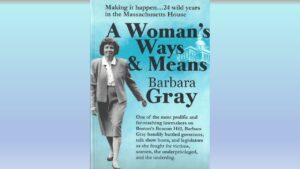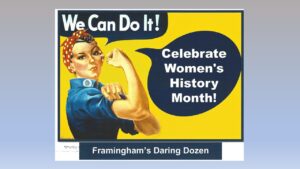Disclosure: This post may have affiliate links and we may earn compensation when you click on the links at no additional cost to you.
Barbara Gray: Pioneering Advocate for the Underdog
In a previous post, I discussed my experience with crafting and giving my first Zoom presentation. The presentation is about Barbara Gray, a pioneering advocate for the underdog and underprivileged in Massachusetts. Barbara was a powerhouse of a state legislator, serving for 24 years in a very male dominated state house. As Women’s History Month draws to a close, it’s fitting to post about someone who advanced Women’s Rights early on, and was responsible for many of the laws and privileges that women take for granted today.
I helped Barbara write her memoir, A Woman’s Ways and Means: 24 Wild Years in the Massachusetts House. How I met Barbara, and how I became her co-writer is covered in the presentation below.

Who was Barbara Gray and why should you care? And why a book?
I chose the word extraordinary, as she was a real mix of guts, verve, savvy, energy, persistence, and femininity along with fun and humor thrown in. She was a legend in the Mass State House for her personality and ahead of the curve bills. She made “good trouble” like John Lewis said.
Why is she particularly notable? She early on championed women’s and victim’s rights, social issues, and the environment. While Ruth Bader Ginsberg was working in the courts on a national level for social justice, especially for women, Barbara was working on laws on the state level. Like Ginsberg, she often pointed out to male power brokers, that ending discriminatory laws and practices benefited men as well as women.
Here’s a photo of Barbara that I feel captures much of her personality. You get an idea of her confidence and humor.

What was the difference Barbara Gray made?
She was Framingham’s first female legislator and served for 24 years, from 1972 to 1996, under four governors, from Sargent to Weld. Anyone living or passing through Massachusetts is affected by her diligence and dedication to social and cutting edge legislation.
Barbara worked long and hard on improving the quality of life in Massachusetts, ending many forms of discrimination, and providing help for the battered and the underdog. Her influence has had a ripple effect nationally as many other states passed bills echoing hers.
She was stirring the pot during the formative political careers of some of Massachusetts best and brightest, including Barney Frank, Ed Markey, Ray Flynn, and Andrew Card, who worked in the Reagan and George HW Bush White Houses and was George W. Bush’s White House Chief of Staff. They bonded as they overcame not having telephones or aides. They shared a lackluster room and even the Men’s Room as there weren’t any Women’s bathrooms in the State House.
Senator Ed Markey, who wrote the Forward to her memoir recalled: “We met in the Massachusetts State Legislature in 1972,(it was} a bastion of white male Irish and Italian politicians. Every one of us had our consciousness raised like an elevator by Barbara Gray, and we are better men for it!”

Meeting Barbara Gray, the pioneering advocate for the underdog
Barbara and I met, as many did, because of neighborhood issues. It was near the end of her career and when I was a neighborhood activist. At her retirement roast, (her third roast, I would discover) Massachusetts best known and top politicians showed up, including Markey and Barney Frank, and praised her for work on all kinds of issues. This was news to me. I only knew some of her local work on preservation, neighborhood, and shelter issues.
As a historian and writer, it struck me that her story should be written down because a lot of “herstory” gets forgotten and lost over time.
To prove my point, some people who’ve seen the notices about this talk have asked me who she was.
I approached her about collaborating on a book about her career and impact. I had no idea what I was getting into.

Writing Barbara Gray’s life as a pioneering advocate
First of all, Barbara was a very energetic person. She seemed to find it hard to settle down to the business of writing. It ended up that she would “talk” the basis of the book. I would interview her and record and transcribe each session. She gave me boxes full of campaign materials, newspapers clippings, and videotapes. This was a sign from one of her 12 campaigns.
I traveled to the State House to interview her fellow representatives and to dig up material in the Special Collections Archives. It wasn’t hard to dig as she was a prolific legislator. What was hard was sifting through so much material. I got to be on a first name basis with the librarians due to the many trips I made there.
This was when the Internet was still in it’s infancy as far as online databases. I trekked to many libraries, including the Wellesley Public Library and the Whittemore at Framingham State, in order to use their newspaper indexes and locate articles on microfilm. I stitched together her taped recollections with background material on her initiatives and State House adventures.
Barbara reviewed what I wrote and called on friends, including Former Framingham State professor Mary Murphy, to proofread and edit.
So that’s how the book came about. Now, let’s delve into how extraordinary Barbara Gray was, why we should care, and how her influence lives on.
How Barbara Gray became a pioneering advocate for the underdog
There she was, a newly elected housewife and mother of four, taking a bus into the Mass. State House. Her husband had encouraged her to run, because at least she would be paid something for all the time she spent on community projects. She was one of only eight women there in 1973.
Yet, she was persistent and then some, way before Elizabeth Warren. Barney Frank dubbed her “The Holy Pest of good causes…” She had a tough enough resiliency to not let attacks and subversion of her goals get her down. One of her major qualities was her sense of humor. She could laugh at herself and turn a negative into a positive.
When she was harassed and attacked by foes, in the media, especially on talk shows, she felt they were helping to spread the word about her and her latest bill. Howie Carr often mentioned her on his show and in his column at the Boston Herald. The late caustic talk show host Jerry Williams would devote many an hour to fanning animosity against her seatbelt bills. She would say “I’m not afraid of Jerry Williams, he’s made me a household name!”
She would chase the Speaker of the House up or down the State House stairs saying, “I’ve gotta have this bill, I’ve gotta have this bill,” while it had to be annoying, he kept his respect for her and put her on the powerful Ways and Means Committee. Pretty good when she was a Republican in a mostly Democratic House.
She could be a bit outrageous, or push limits, but people would shrug their shoulders, say, “That’s Barbara,” and forgive her. Her followers stayed loyal to her.
Any woman who ran for the Massachusetts legislature back then had to have some pluck. There were only 8 women in the body of 280 representatives. In other words, one female for every 30 males.
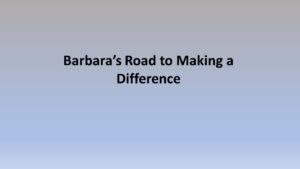
The evolution of Barbara Gray as a pioneering advocate for the underdog
When Barbara first started getting involved in local issues, she would hold neighborhood meetings in her small barn which was furnished with well-worn couches and scratched furniture. Remember now that she was the mother of four. She would ask everyone to bring a snack or beverage and have laundry baskets of her family’s clothes set out and people would sort and fold as they talked.
Barbara got her political feet wet when she co-founded the Framingham League of Women Voters, served on the Planning Board, and the Metropolitan Area Planning Council. She ran on the Republican ticket because there was an opening. However, her leanings became clear. A former Speaker of the House called her “The best Democrat we ever had in the Republican Party.”
It didn’t matter that Framingham was basically a Democrat’s town. Barbara kept getting re-elected. Later in her career, in typical jaunty and savvy fashion, she would become a Democrat. It was via a write-in campaign when she lost the Republican primary.
So what did Barbara work on?
Barbara Gray’s bills and issues
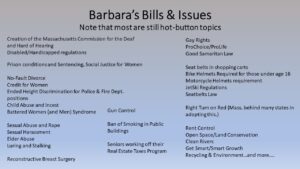
Beginning with Zoning
Barbara had an interest in zoning from being on the Framingham Planning Board. One of her early bills was about zoning. Her intensive efforts with a male co-sponsor were sabotaged by an opponent, a paraplegic. Back then there was one final copy and bills sometimes “disappeared.” The paraplegic took it home with him. She re-introduced the bill and threatened to take his crutches away if anything happened to it.
Championing social issues
She evolved into championing social issues. Framingham is home to The Learning Center for the Deaf, and her deaf constituents couldn’t call her as the State House didn’t have a TTY machine. After asking the State House clerk and the Speaker if they wanted a TTY machine in their offices and getting “no’s,” she had one put in her office. Then she made anyone who received a message via the machine come down to her office to get it. Eventually TTY’s were installed throughout the State House.
She noticed height discrimination as most women, and short men, couldn’t join the police force or fire department due to height requirements. She also recognized other forms of discrimination, such as women having trouble getting credit, credit cards, loans, etc. as there were requirements for a spouse or male family member to co-sign. Think of it: How would you feel if you couldn’t get a credit card or loan without a male’s permission? Your grandmother and probably your mother couldn’t until the laws were changed. One bill after another for women related issues followed. Some passed easily, others not. She would point out how a bill might benefit men, as well as women. As in, short men were discriminated against too, when it came to police and fire department positions. And men could also get breast cancer, as one legislator did, which enlightened their attitude towards insurance coverage.
A pioneering advocate for battered women
A big success had to do with battered women. She shone a light on the problem and had a huge hand in the acknowledgement that there is such a thing as Battered Women’s Syndrome. Before Barbara, domestic violence was downplayed by the police and media in Massachusetts. Police logs, if a record was kept, used euphemisms. Newspapers, if they mentioned a domestic disturbance, didn’t identify the batterer by name, to “protect reputations.” When asked whether or not names should be published, she replied: “Publish.” And that was the beginning of the end of the silence about the epidemic of Domestic Violence. She was behind the first publicly funded battered women’s shelter in Massachusetts. Battered women’s shelters in general weren’t common before then. She helped with raising awareness and fundraising.
She worked on Ted Kennedy to create a national domestic violence 800 number for women and men in trouble.
When she was pushing the No-Fault Divorce Bill, she ended up meeting with the Archbishop of Boston who ended up not opposing it. She also called up the wife of the legislator who strongly opposed it. He changed his position, too.
Seinfeld, Phil Donohue, Harvey Milk
She was on a number of national TV Shows, including the Today Show. Phil Donohue featured her on a show discussing Victim’s Rights. Her victim witness bill, the Samaritan Bill, required witnesses to report a crime. She crafted the bill after a woman was gang raped on a pool table in New Bedford in 1983 in front of onlookers.
An interesting sidelight is that her Good Samaritan law was the framework of the Seinfeld Show finale. You might remember that the Seinfeld characters were arrested and jailed in a mythical Massachusetts town. Why? Because they had violated a Good Samaritan law by watching and laughing at a victim of a car jacking and not reporting it.
She was the original sponsor of Gay Rights Legislation following the assassination of Harvey Milk in 1978. This moved Massachusetts to the forefront of the Gay Rights movement.
She also worked to pass legislation about Sexual Harassment, luring, stalking, recycling, scenic roads. Another focus was prisoner’s rights, especially of women at MCI-Framingham, Massachusetts only women’s prison.
A persistent advocate for seatbelt legislation
Barbara’s biggest and perhaps ugliest fight, was her ten year battle to get a Seat Belt law passed. She had seat belt bills in the works from 1983 to 1994. She was the target of death threats and scorching letters to the Editor about her bills. Letter writers would say they wanted to wrap a seat belt around her neck and other nasty things. Jerry Williams, Gene Burns, and Howie Carr devoted hours of their talk shows to lambasting her and stirring up opposition. When she got a seat belt bill passed, the opposition got enough signatures for a referendum and it was repealed. The day after the bill was repealed, she called a press conference and re-filed. Jerry Williams was beside himself and she ended up in a political cartoon.
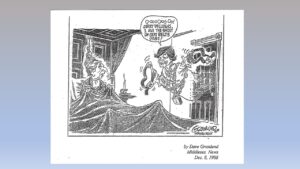
Another bill was passed, but Gov. Weld vetoed it on Jerry Williams’ show. She re-filed. Finally, with the help of many head injury groups, and two sick legislators, one in a wheelchair, who came in for the vote, a seat belt law was passed in her last year in office.
The seat belt saga included a lot of related safety bills. She is the reason that there are seat belts in shopping carts, jetski regulations, and that motorcyclists must wear helmets. She took a tremendous amount of heat from motorcyclists over that.
Barbara Gray as an advocate for Framingham State University

Not as well known is that Barbara was a very good friend of Framingham State and IAFSA. The Ecumenical Center, AKA the Chapel fell into disrepair. Due to disinterest on the part of the college administration at the time, it was closed up and neglected. Slate shingles on the roof broke and fell off, animals and weather were getting in. A fence was put up around it to keep people away from it.
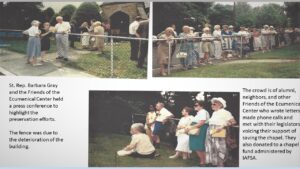
Here’s the fence and you can see the many alumni and supporters who were part of the Friends of the Ecumenical Center which advocated for the Chapel’s restoration.
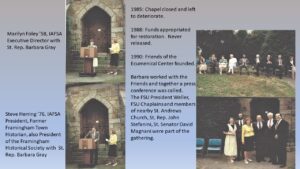
Barbara worked with the Friends of the Ecumenical Center, which met at Alumni House. Steve Herring, IAFSA president, and Marilyn Foley, IAFSA Director and many alums were part of the group. Barbara was a big one for calling press conferences and public events to call attention to a cause. Here you see her in the yellow jacket in action for the Ecumenical Center. After many years and setbacks regarding state funding, Barbara and the Friends prevailed. Marilyn Foley said the restoration wouldn’t have been possible without Barbara’s efforts.

A sign of Barbara and the group’s success. Although her work on the chapel had put her somewhat at odds with some people at FSU, they chose her as a graduation speaker and gave her an honorary degree.
Barbara Gray’s archives are at Framingham State University
After the book was finished, I contacted the Whittemore Library and with Barbara’s blessing I donated several boxes of her archives and my research notes. This included hundreds of newspaper articles about her activities and bills, videotapes of TV shows she was on, fact sheets, press releases, radio spots, interviews, and awards.
What I learned about politics from Barbara Gray
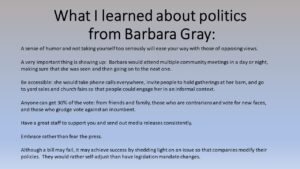
Say your most important points first during an interview or debate as you can get cut off, or sidetracked.
A sense of humor and not taking yourself too seriously will ease your way with those of opposing views.
A very important thing is showing up: Barbara would attend multiple community meetings in a day or night, making sure that she was seen and then going on to the next one. — She seemed to be everywhere there was a “happening” and her name and photo was often in the news.
Be accessible: she would take phone calls everywhere, invite people to hold gatherings at her barn, and go to yard sales and church fairs so that people could engage her in an informal context.
Anyone can get 30% of the vote: from friends and family, those who are contrarians and vote for new faces, and those who grudge vote against an incumbent.
Have a great staff to support you and send out media releases consistently.
Embrace rather than fear the press.
Although a bill may fail, it may achieve success by shedding light on an issue so that companies modify their policies. Often, corporations would rather self-adjust than have legislation mandate changes.
She retired from the legislature, but she didn’t retire from advocating
Following her retirement from the legislature, Barbara worked on the book, co-hosted a local public access TV show, traveled to Africa, and helped with more local issues and other people’s campaigns. In 2004, after her second husband unexpectedly died, Barbara packed up and moved to Wellfleet, Mass. There she got on the Planning Board, Library Board, Lower Cape TV Access Board, a community preservation committee, and several other groups. Whew! Retirement wasn’t for her.
Barbara passed away in 2014 at the age of 87. You can read her obituary in The Boston Globe.
Barbara Gray’s legacy as an advocate lives on
In 2003, Steve Herring ’76, and as I mentioned a former IAFSA president and Town historian, made a list of 10 Framingham women whom he felt should be recognized as part of a hypothetical Framingham Women’s Memorial, or a Women’s Hall of Fame. He chose 10 women of great “talent, ability, and strength.” Among them were Sarah Clayes, who had fled the Salem Witch Trials and settled in Framingham, Margaret Knight, the inventor of the first paper bag folding machine, and Christa McAuliffe ’70.
In 2018, The Framingham History Center put out the call for nominations to add two more outstanding women to Steve’s list, to make a “Daring Dozen.” Then, the public votes on the nominations and Barbara won yet another election. I was asked to make some brief remarks at a special event celebrating Women’s History Month. The Framingham History Center posted a video of the program. My presentation was at the end of the video. You can see it here.
I decided to use the words of those who knew and worked with Barbara.
What people and the media said about Barbara Gray
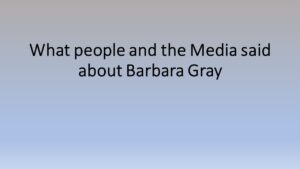
Howie Carr, Boston radio talk show host, WRKO, and Boston Herald columnist: “the crazy lady of Metrowest.” “We shall not see (her) like again. Knock on wood.”
Jerry Williams, Boston radio talk show host, WRKO: “she’s a very strange lady.” That old biddy, does she ever sleep?..
The Boston Globe: “…a no-nonsense proponent of human services and environmental protections.
Middlesex News: “one of the state’s most able, knowledgeable and principled lawmakers.”
Barney Frank, U.S. Congressman: “In the thirty years—so far—that I have been a legislator, I can think of no colleague who has worked harder, more effectively, or with more dedication for the kind of society we want to live in, than Barbara Gray. Potential do-gooders seeking a how-to manual will find no better expert o this subject than Barbara.”
Lois Pines, Mass. State Rep. and St. Senator: “Barbara and I were leaders of a dynamic group of women legislators who, in the 1970’s, through advocacy, legislation, and commitment, changed the lives of women and children forever.”
Charles Flaherty, former Massachusetts Speaker of the House: “For… 24 years Barbara Gray has accepted a special responsibility to advance the public interest, to fight injustice, and to work with us for the vitality of Framingham and the Commonwealth and its people. She’s helped us clarify and
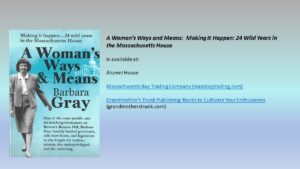 define the difficult choices facing us as a legislature, a state, and a society.”
define the difficult choices facing us as a legislature, a state, and a society.”
So thank you for listening. Going back through my files and notes about Barbara has given me a new appreciation of what women (and men) owe to her diligence on so many issues. I hope I have raised awareness of some Massachusetts Herstory.
Want to learn how to start a blog?
Here’s some courses to get you started: Start A Travel Blog

